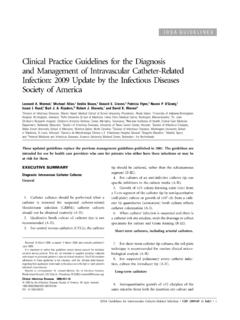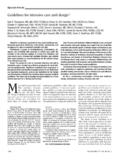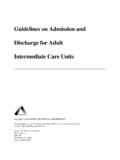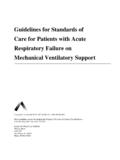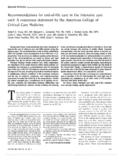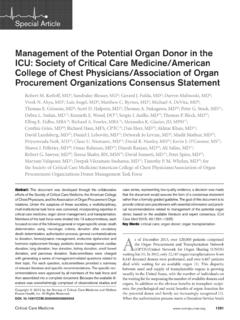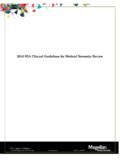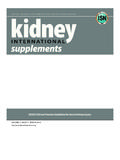Transcription of Clinical Practice Guidelines for the Management of …
1 Critical Care Medicine 263 Special ArticleClinical Practice Guidelines for the Management of Pain, Agitation, and Delirium in Adult Patients in the Intensive Care UnitJuliana Barr, MD, FCCM1; Gilles L. Fraser, PharmD, FCCM2; Kathleen Puntillo, RN, PhD, FAAN, FCCM3; E. Wesley Ely, MD, MPH, FACP, FCCM4; C line G linas, RN, PhD5; Joseph F. Dasta, MSc, FCCM, FCCP6; Judy E. Davidson, DNP, RN7; John W. Devlin, PharmD, FCCM, FCCP8; John P. Kress, MD9; Aaron M. Joffe, DO10; Douglas B. Coursin, MD11; Daniel L. Herr, MD, MS, FCCM12; Avery Tung, MD13; Bryce R. H. Robinson, MD, FACS14; Dorrie K. Fontaine, PhD, RN, FAAN15; Michael A. Ramsay, MD16; Richard R. Riker, MD, FCCM17; Curtis N. Sessler, MD, FCCP, FCCM18; Brenda Pun, MSN, RN, ACNP19; Yoanna Skrobik, MD, FRCP20; Roman Jaeschke, MD21 1 VA Palo Alto Health Care System, Palo Alto, CA, and Stanford University School of Medicine, Stanford, CA.
2 2 Tufts University School of Medicine, Maine Medical Center, Portland, ME. 3 Department of Physiological Nursing, University of California, San Francisco, CA. 4 VA-GRECC (Geriatric Research Education Clinical Center) for the VA Tennessee Valley Healthcare System, Vanderbilt University Medical Center, Nashville, TN. 5 Ingram School of Nursing, McGill University and Centre for Nursing Research/Lady Davis Institute, Jewish General Hospital, Montreal, QC, Canada. 6 The Ohio State University, College of Pharmacy, Columbus, OH, and The University of Texas, College of Pharmacy, Austin, TX. 7 Scripps Clinical Center, Scripps Health, La Jolla, CA. 8 Department of Pharmacy Practice , Northeastern University Special and Scientific Staff, Division of Pulmonary, Critical Care, and Sleep Medicine, Tufts University of Medicine, Boston, MA.
3 9 Department of Medicine, Section of Pulmonary and Critical Care, University of Chicago, Chicago, Department of Anesthesiology and Pain Medicine, University of Washington/Harborview Medical Center, Seattle, Departments of Anesthesiology and Internal Medicine, University of Wisconsin School of Medicine and Public Health, Madison, Shock Trauma Center, Division of Trauma Critical Care Medicine, University of Maryland, Baltimore, Department of Anesthesia and Critical Care, University of Chicago, Chicago, Department of Surgery, Division of Trauma and Critical Care, University of Cincinnati, Cincinnati, University of Virginia, School of Nursing, Charlottesville, Baylor University Medical Center, Dallas, Tufts University School of Medicine, Maine Medical Center, Portland, Department of Internal Medicine, Virginia Commonwealth University Heath System, Richmond, Department of Allergy, Pulmonary, and Critical Care Medicine, Vanderbilt University Medical Center, Nashville, Universit de Montr al, Montr al, Departments of Medicine and Clinical Epidemiology and Biostatistics, St.
4 Joseph s Hospital and McMaster University, Hamilton, Ontario, digital content is available for this article. Direct URL cita-tions appear in the printed text and are provided in the HTML and PDF ver-sions of this on the journal s Web site ( ).To minimize the perception of bias in these Guidelines , individual Task Force members with a significant conflict of interest on a particular topic were recused from grading the literature, writing evidence summaries, and developing specific statements and recommendations on that topic. Final decisions regarding strength of evidence and strength of recommenda-tions for all questions were voted on anonymously by all Task Force mem-bers. Voting distributions for all statements and recommendations can be found on line at We refer readers to the Methods Section of these Guidelines for more Organizations: American College of Critical Care Medicine (ACCM) in conjunction with Society of Critical Care Medicine (SCCM) and American Society of Health-System Pharmacists (ASHP).
5 Mr. Dasta has consultancies with Hospira, Axel Rx, Cadence Pharmaceuti-cals, and Pacira Pharmaceuticals and has received honoraria/speaking fees from the France Foundation (speakers bureau CME program) sponsored by Hospira. Dr. Devlin has received honoraria/speaking fees, consultancies, and grants from Hospira. Dr. Ely has received honoraria/speaking fees from GSK and Hospira; and has received grants from Hospira, Pfizer, and As-pect. Dr. Herr has received honoraria/speaking fees from Hospira. Dr. Kress has received honorar ia/speaking fees from Hospira; and has received a grant from Hospira (unrestricted research). Ms. Pun has received honoraria/speaking fees from Hospira. Dr. Ramsay has received honoraria/speaking fees from Hospira and Masimo; and has received a grant from Masimo.
6 Dr. Riker has consultancies with Masimo; and has received honoraria/speak-ing fees from Orion. Dr. Sessler has received honoraria/speaking fees from Hospira and consulting fees from Massimo. The remaining authors have not disclosed any potential conflicts of Guidelines have been reviewed and endorsed by the American Col-lege of Chest Physicians and the American Association for Respiratory Care; are supported by the American Association for Respiratory Care; and have been reviewed by the New Zealand Intensive Care information regarding this article, E-mail: American College of Critical Care Medicine (ACCM), which honors individu-als for their achievements and contributions to multidisciplinary critical care medi-cine, is the consultative body of the Society of Critical Care Medicine (SCCM) that possesses recognized expertise in the Practice of critical care.
7 The College has developed administrative Guidelines and Clinical Practice parameters for the critical care practitioner. New Guidelines and Practice parameters are continually developed, and current ones are systematically reviewed and Care 2013 by the Society of Critical Care MedicineDOI: et al264 January 2013 Volume 41 Number 1 Objective: To revise the Clinical Practice Guidelines for the Sus-tained Use of Sedatives and Analgesics in the Critically Ill Adult published in Critical Care Medicine in : The American College of Critical Care Medicine assembled a 20-person, multidisciplinary, multi-institutional task force with expertise in guideline development, pain, agitation and sedation, delirium Management , and associated outcomes in adult critically ill patients.
8 The task force, divided into four subcommittees, collaborated over 6 yr in person, via teleconferences, and via electronic communication. Subcommittees were responsible for developing relevant Clinical questions, using the Grading of Recommendations Assessment, Development and Evaluation method ( ) to review, evaluate, and summarize the literature, and to develop Clinical statements (descriptive) and recommendations (actionable). With the help of a professional librarian and Refworks database software, they developed a Web-based electronic database of over 19,000 references extracted from eight Clinical search engines, related to pain and analgesia, agitation and sedation, delirium, and related Clinical outcomes in adult ICU patients.
9 The group also used psychometric analyses to evaluate and compare pain, agitation/sedation, and delirium assessment tools. All task force members were allowed to review the literature supporting each statement and recommendation and provided feedback to the subcommittees. Group consensus was achieved for all statements and recommendations using the nominal group technique and the modified Delphi method, with anonymous voting by all task force members using E-Survey ( ). All voting was completed in December 2010. Relevant studies published after this date and prior to publication of these Guidelines were referenced in the text. The quality of evidence for each statement and recommendation was ranked as high (A), moderate (B), or low/very low (C).
10 The strength of recommendations was ranked as strong (1) or weak (2), and either in favor of (+) or against ( ) an intervention. A strong recommendation (either for or against) indicated that the intervention s desirable effects either clearly outweighed its undesirable effects (risks, burdens, and costs) or it did not. For all strong recommendations, the phrase We recommend .. is used throughout. A weak recommendation, either for or against an intervention, indicated that the trade-off between desirable and undesirable effects was less clear. For all weak recommendations, the phrase We suggest .. is used throughout. In the absence of sufficient evidence, or when group consensus could not be achieved, no recommendation (0) was made.

